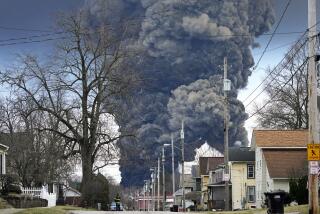Pittsburgh Suburbs Get Water Again as Slick Moves On
- Share via
PITTSBURGH — A drinking water crisis spawned by a massive oil spill into the Monongahela and Ohio rivers eased somewhat Wednesday as a major utility began pumping heavily filtered water into the depleted storage tanks in suburbs south of here.
Water service was resumed for about 23,000 residents who had been forced for two days to line up for emergency supplies from military water trucks, and pressure went back up for an additional 300,000 residents who had been threatened with cutoffs.
Nevertheless, mandatory conservation measures were expected to remain in effect through the weekend as cleanup efforts continued in near-zero temperatures.
Meanwhile, several communities downstream in Ohio and West Virginia had close calls with the slick, and others nervously awaited its arrival.
The contamination began last Saturday, when an Ashland Oil Co. holding tank ruptured at Floreffe, Pa., 25 miles south and upstream from Pittsburgh, spilling 1 million gallons of diesel fuel into the Monongahela, which joins the Allegheny River to form the Ohio below Pittsburgh.
No Permits for Tank
Ashland spokesmen conceded that the company had never obtained a permit to erect the 40-year-old storage tank, which was reassembled at Floreffe after being dismantled at another Ashland facility near Cleveland. Moreover, the company conceded that the reassembled tank had not been first filled completely with water to test for leaks, as would normally have been done.
However, John R. Hall, chairman and chief executive officer of Ashland, said that conversations with Allegheny County Fire Marshal Martin Jacobs had “led our people to believe they had authority to proceed” with construction. Jacobs disputed the claim.
Hall apologized for “inconvenience” from the spill and said the company would pay for the cleanup.
Authorities expressed hope that the toxic pollutants flowing downstream have been diluted enough to avoid major problems for 2 million people who drink water drawn from the Ohio River between Pittsburgh and Cincinnati.
But extensive precautions were being taken, as federal agencies lined up barges to ferry water to needy municipalities, and Ohio Gov. Richard F. Celeste called for conservation and readied emergency services.
City Closes Intake Pipes
At 4:30 p.m. Wednesday, Steubenville, Ohio, closed intake pipes 20 feet deep in the Ohio River when the leading edge of a 20-mile-long mass of emulsifying water and oil reached the city’s outskirts.
Steubenville, which serves about 40,000 customers, had only a 36-hour reserve of water. But Mayor David Hindman said by telephone that he was cautiously optimistic because East Liverpool, Ohio--situated 30 miles upstream--had had to shut down for only a day before being able to resume pumping.
The oil mass, which began as a six-inch-deep slick but has been churned down to a depth of about 18 feet, has been slowed considerably by ice floes and is not expected to reach Cincinnati for nearly three weeks.
“That’s good. It gives the oil more time to dissipate,” said Jeanne Ison with the Ohio River Valley Water Sanitation Commission (ORSANCO), a consortium of utilities along the Ohio River.
Cleanup Crews Struggle
On the other hand, the dispersion makes it harder for cleanup crews from Ashland Oil to remove the diesel oil from the river. The crews were also hampered by ice and arctic temperatures.
Less than 100,000 gallons of the gooey, smelly diesel has been corralled by plastic booms and vacuumed from the Monongahela and Ohio, according to Ray Germann, spokesman for the U.S. Environmental Protection Agency.
State and federal investigations have been started into the incident.
One question concerns how quickly officials responded in trying to contain the spill in the critical early stage, when it was still easy to skim from the surface of the river.
About six hours elapsed between the collapse of the tank and placement of the first boom several miles downstream.
“That’s a fairly reasonable time. Nobody knew how much of a problem it was until then,” said Dennis Casey of the Western Pennsylvania Water Co., the major utility affected by the fouled river.
13-Hour Gap
However, about 13 hours elapsed before a second boom, 20 miles downstream in Pittsburgh, was in place to catch oil that had escaped the first boom.
“The Coast Guard was a little slow on the second boom, and that hurt,” Casey said.
Relief for the suburbs south of Pittsburgh occurred at 3:30 p.m. Wednesday, when the Western Pennsylvania Water Co. resumed pumping at 25% capacity.
The utility was cleared by federal, state and county officials to use 16 times more activated charcoal than normal for filtering out contaminants, including cancer-causing benzene.
“This is a significant easing of the crisis, but the crisis will still exist until we can dip the damn oil out of here--hopefully by Monday,” Casey said.
Recommend Sponge Baths
Officials stressed the need for continued conservation and urged residents to take only sponge baths and to reduce flushing of toilets.
In Dormont, police shut down a car wash that was continuing to operate right next door to the Western Pennsylvania Water Co. offices.
More to Read
Sign up for Essential California
The most important California stories and recommendations in your inbox every morning.
You may occasionally receive promotional content from the Los Angeles Times.












